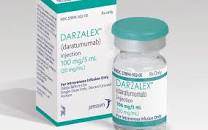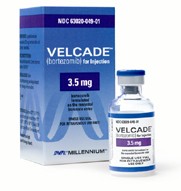
Recently Diagnosed or Relapsed? Stop Looking For a Miracle Cure, and Use Evidence-Based Therapies To Enhance Your Treatment and Prolong Your Remission
Multiple Myeloma an incurable disease, but I have spent the last 25 years in remission using a blend of conventional oncology and evidence-based nutrition, supplementation, and lifestyle therapies from peer-reviewed studies that your oncologist probably hasn't told you about.
Click the orange button to the right to learn more about what you can start doing today.
- You are here:
- Home »
- Blog »
- Multiple Myeloma »
- DRd vs. VRd as induction therapy for NDMM?
DRd vs. VRd as induction therapy for NDMM?

This real-life survey indicates that re-treatment including bortezomib as a first salvage therapy could be still considered in MM patients achieving durable response after initial exposure to bortezomib (velcade).”
Let’s suppose that you have just been diagnosed with multiple myeloma (MM). You either don’t want to have or can’t have an autologous stem cell transplant (ASCT). Your oncologist conveys the findings of the first study linked and excerpted below. In short, DRd (darzelex, revlimid, dex.) provides, on average, a longer “PFS” than the current standard-of-care induction therapy RVd aka revlimid, velcade, dexamethasone.
The average newly diagnosed MM patient would say great, I’ll do the darzelex with R and d please!
And that decision is fine. As long as you understand all relevant information. Relevant to you that is.
- Keep in mind that this is what is called an indirect treatment comparison of chemo combos, regimens. Secondly, this indirect comparison of RVd, DRd, compares your first remission only.
- I think it is great that a given regimen gives, on average, a longer first remission. However, I’ve always felt that the key to any/all therapies is OS aka overall survival aka length of life as well as quality of life. The write-up says nothing about the short, long-term and late stage side effects associated with DRd.
- Lastly, I try not to sound conspiratorial when I write blog posts but there are enough conflicts of interest listed below to raise legit concerns about the findings of the study. I think it is unconscionable how much money oncologists received directly from big pharma. Janessen is J&J- same company. Janssen produces Daratumumab aka Darzelex. We’re are talking tens of 000’s here people!
The reality of modern day MM treatment is
- remission,
- relapse,
- remission,
- relapse
- until multi-drug resistance (MDR).
As the saying goes, MM is a marathon, not a sprint.
The challenge to you then, is to think through, as much as possible, a treatment plan that accounts for all available conventional and non-conventional therapies. By conventional, I mean chemotherapy regimens such as Daratumumab as well as Bortezomib (Velcade). It is not one or the other but both- over a period of years.
Consider the idea that “less is more” as the saying goes. Chemotherapy is toxic. Toxicity damages you-short, long-term and late stage. A long PFS is important. But toxicity, how you feel during that PFS, is just as important.
Just as importantly, consider what the second study below is saying. If the NDMM patient undergoes Bortezomib/velcade as induction therapy, MM patients can use it again or “rechallenge” your MM with it again.
Evidence-based, non-conventional therapies, in my experience anyway, must be part of the NDMM therapy plan.
NDMM patients must balance the damage done my their MM and the damage done by chemotherapy.
If you’d like to learn more about managing your MM for the long-term, scroll down the page, post a question or a comment and I will reply to you ASAP.
Thank you,
David Emerson
- MM Survivor
- MM Cancer Coach
- Director PeopleBeatingCancer
Recommended Reading:
- Multiple Myeloma, Chronic Pain and Cure vs. Control
- Stem Cell Transplants Increase Risk of Skin Cancers
- Myeloma Diagnosis- ASCT vs. Novel Therapies?
Daratumumab-lenalidomide-dexamethasone vs standard-of-care regimens: Efficacy in transplant-ineligible untreated myeloma
“Daratumumab (Darzelex) in combination with lenalidomide-dexamethasone (D-Rd) recently received FDA approval for the treatment of transplant-ineligible patients with newly diagnosed multiple myeloma (NDMM).
The present PEGASUS study compared progression-free survival (PFS) in patients treated with D-Rd in the MAIA trial and patients treated with common standard-of-care regimens from the Flatiron Health electronic health record-derived deidentified database, which has data from patients treated primarily at community-based oncology practices in the United States.
Individual-level patient data from both data sources were used to perform an anchored indirect treatment comparison (ITC) of Darzelex-Rd to bortezomib-lenalidomide-dexamethasone (VRd) and bortezomib-dexamethasone (Vd); lenalidomide-dexamethasone (Rd) was the common anchor for the ITC…
After application of MAIA inclusion/exclusion criteria and propensity-score weighting, the Flatiron Health patients resembled the MAIA trial population on measured baseline characteristics.
Based on the direct comparison within MAIA, treatment with D-Rd was associated with a significantly lower risk of progression or death compared to Rd. Based on the ITCs, D-Rd was associated with a significantly lower risk of progression or death compared to VRd and Vd.
In the absence of head-to-head trials comparing Darzelex-Rd to VRd or Vd, the present ITC may help inform treatment selection in transplant-ineligible patients with NDMM.
Conflict of interest statement
BD ‐ Consultancy: Amgen, Celgene, Johnson & Johnson, and Takeda. SK ‐ Takeda: Research Funding: Takeda, Janssen, Celgene; Consultancy: Janssen, Celgene. SU ‐ Speakers bureau: Amgen, Celgene, Janssen, Sanofi, Takeda; Research Funding: Amgen Array Biopharma, Bristol‐Myers Squibb, Celgene, Janssen, Merck, Pharmacyclics, Sanofi, Takeda; Consultancy: Amgen, Bristol‐Myers Squibb, Celgene, Janssen, Merck, SkylineDx, Takeda. EA, AL, and RK ‐ Employment and equity: Janssen. EM was employed by Janssen when the study was conducted. TF ‐ Advisory committee: Celgene, Janssen, Takeda, Amgen, Sanofi; Speakers bureau: Celgene, Janssen, Takeda.
Is re-challenge still an option as salvage therapy in multiple myeloma? The case of REal-life BOrtezomib re-Use as secoND treatment for relapsed patients exposed frontline to bortezomib-based therapies (the REBOUND Study)
“Therapeutic re-challenge is currently a debated issue in the field of multiple myeloma (MM), given the recent availability of several new drugs and combinations.
However, very few specific evidences are available about bortezomib re-use at first relapse. This multicenter, observational, retrospective study enrolled 134 MM patients with significant response after bortezomib-based frontline regimens and who had received a first salvage treatment containing bortezomib at relapse.
The overall response rate was 71%, including
- 40% partial responses,
- 24% very good partial responses, and
- 7% complete responses.
Re-treatment was well-tolerated, with no significant new or unexpected toxicities observed.
The median duration of second progression-free survival (PFS) was 15 months, while median PFS2 was 55 months. With a median follow-up of 56 months, overall survival was 94 months for the entire series, without significant differences between patients undergoing or not undergoing transplant procedures.
This real-life survey indicates that re-treatment including bortezomib as a first salvage therapy could be still considered in MM patients achieving durable response after initial exposure to bortezomib.”



